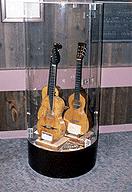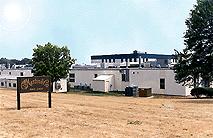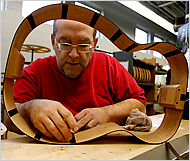Home Page |
Writings Index
Martin Guitar Factory Tour
By: Doug Bittinger - Sept. 2000
Originally written as part of the Wandering Woodworker series
of articles published by Today's Woodworker Magazine.
 This month my wanderings will take
us into a realm where many wood workers fear to tread. Musical
instruments. The guitar in particular.
This month my wanderings will take
us into a realm where many wood workers fear to tread. Musical
instruments. The guitar in particular.
Allow me to immediately and forthrightly admit that I have
absolutely no musical talent whatsoever. Still, I
enjoy listening to music and find the delicate tones of a
well played acoustic guitar to be delightful.
A short time ago I attended a John Pizzareli concert and a
Classic Guitar Show. After seeing some of this
masterful work close up (and enviously admiring the sounds
John gets out of his seven string guitar), I decided to learn
more about guitar making. Since I like to learn from
the best, I decided to call on the Martin Guitar Company at
510 Sycamore Street in Nazereth PA.
Tours of the factory, if you dare to call it that, are free
for small groups. Large groups are $2.00 per person
and must be arranged in advance. Photography is allowed as
long as you don't use a flash. If you like, they
will gladly give you a sound hole cut-out as a souvenir.
First the (brief) history lesson. The Martin Guitar
Company was founded by Christian Frederick Martin Sr., born
Jan. 31, 1796 in Markneukirchen Germany. When the
young C.F. Martin finished his apprenticeship as a guitar
maker and hoped to open a shop of his own, most guitar makers
belonged to the Cabinet Makers Guild. The Violin
Makers Guild became concerned about the impact that the
guitar would have on the musical instrument world, and began
a slanderous campaign to discredit the instrument.
They charged that violins were instruments created by
artisans for artists. Guitars, on the other hand, were
produced by Cabinet Makers: mechanics who produced furniture,
and were no more a musical instrument than was a chair.
Since the guitar's inception had only been 35 years
earlier (by Georg Martin, C.F. Martin's father) the
battle took it's toll on the marketability of the guitar
in Germany. So on Sept. 9, 1833 C.F. Martin left his
homeland to set up shop in New York City.
As is always the case with a young genius, attempting to sell
something new, it was a rocky start. But by 1850 the
demand for Martin guitars had grown to the point that a new,
much larger 'factory' was built in order to
accommodate the demand for Martin Guitars.
The rest, as they say, is history.
 Today the company is run by
C.F.(Chris) Martin IV, the sixth generation of family members to have
taken the reigns of the company.
Today the company is run by
C.F.(Chris) Martin IV, the sixth generation of family members to have
taken the reigns of the company.
Martin guitars are acclaimed as one of the best guitars in
the world. Many popular musicians use Martins,
including Paul McCartney, Bonnie Raitt, and Eric Clapton,
along with over 500,000 other satisfied owners.
The '1833 Gift Shop' sells Martin guitars; new, used
and antique, strings, supplies, books, clothing, and other
memorabilia. Up the street (10 W. North St.) in the
old Martin factory is Guitarmaker's Connection, which
sells acoustic guitar tonewoods, kits, parts, instrument
making supplies, strings and construction/repair books.
Your tour begins with an optional 17 minute video that shows
the production process, and is narrated by C.F.(Chris) Martin
IV.
 The guitar making area looks
more like a large woodshop than a factory. This is because the
Martin family believes that the rich tone and elegant finish of their
guitars can best be achieved by hand crafting. Therefore, most
of the approximately 300 steps of building a guitar are done by
hand. Only recently have power tools been added, and
very few machines were to be seen. With so many steps
to see, the two hour tour moves along quickly.
The guitar making area looks
more like a large woodshop than a factory. This is because the
Martin family believes that the rich tone and elegant finish of their
guitars can best be achieved by hand crafting. Therefore, most
of the approximately 300 steps of building a guitar are done by
hand. Only recently have power tools been added, and
very few machines were to be seen. With so many steps
to see, the two hour tour moves along quickly.
This is an open environment. You can stand next to
workers as they diligently bend, trim, shape, glue, fit,
sand, stain, lacquer, buff and inspect Martins.
You'll see craftsmen using rasps, files, and carving
knives to shape the neck. Watch for the step that uses
common clothes pins as clamps.
A detailed description of the process is beyond this brief
article, but after seeing it for yourself, you'll really
appreciate the 3 to 6 months of craftsmanship required to
convert rough spruce, rosewood, ebony, and other fine woods
into a finished Martin acoustic guitar.
Ah, if only I could learn to play one.
Till next time!
Video update: